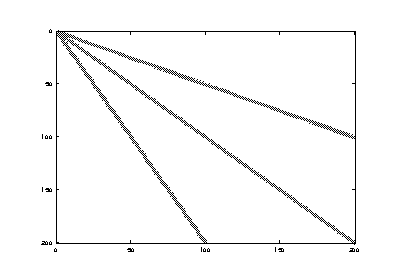| GNU Octave Manual Version 3 by John W. Eaton, David Bateman, Søren Hauberg Paperback (6"x9"), 568 pages ISBN 095461206X RRP £24.95 ($39.95) |
20.1.5 Graphical Representations of Sparse Matrices
The functions described in this section display sparse matrices
graphically. The spy command displays the structure of the
non-zero elements of the matrix. More advanced graphical information
can be obtained with the treeplot, etreeplot and
gplot commands.
- Function File: spy (x)
- Function File: spy (..., markersize)
- Function File: spy (..., LineSpec)
- Plot the sparsity pattern of the sparse matrix x. If the argument
markersize is given as an scalar value, it is used to determine the
point size in the plot. If the string LineSpec is given it is
passed to
plotand determines the appearance of the plot.See also plot
One use of sparse matrices is in graph theory, where the
interconnections between nodes are represented as an adjacency
matrix. That is, if the i-th node in a graph is connected to the j-th
node. Then the ij-th node (and in the case of undirected graphs the
ji-th node) of the sparse adjacency matrix is non-zero. If each node
is then associated with a set of co-ordinates, then the gplot
command can be used to graphically display the interconnections
between nodes.
- Function File: gplot (a, xy)
- Function File: gplot (a, xy, line_style)
- Function File: [x, y] = gplot (a, xy)
- Plot a graph defined by A and xy in the graph theory
sense. A is the adjacency matrix of the array to be plotted
and xy is an n-by-2 matrix containing the coordinates of
the nodes of the graph.
The optional parameter line_style defines the output style for the plot. Called with no output arguments the graph is plotted directly. Otherwise, return the coordinates of the plot in x and y.
See also treeplot, etreeplot, spy
As a trivial example of the use of gplot, consider the example
A = sparse([2,6,1,3,2,4,3,5,4,6,1,5],
[1,1,2,2,3,3,4,4,5,5,6,6],1,6,6);
xy = [0,4,8,6,4,2;5,0,5,7,5,7]';
gplot(A,xy)
which creates an adjacency matrix A where node 1 is connected
to nodes 2 and 6, node 2 with nodes 1 and 3, etc. The co-ordinates of
the nodes are given in the n-by-2 matrix xy.
The dependencies between the nodes of a Cholesky factorization can be
calculated in linear time without explicitly needing to calculate the
Cholesky factorization. The etree command returns the
elimination tree of the matrix. It can be displayed graphically with
treeplot(etree(A)) if A is symmetric or
treeplot(etree(A+A')) otherwise.
- Loadable Function: p = etree (s)
- Loadable Function: p = etree (s, typ)
- Loadable Function: [p, q] = etree (s, typ)
-
Returns the elimination tree for the matrix s. By default s is assumed to be symmetric and the symmetric elimination tree is returned. The argument typ controls whether a symmetric or column elimination tree is returned. Valid values of typ are 'sym' or 'col', for symmetric or column elimination tree respectively
Called with a second argument, etree also returns the postorder permutations on the tree.
- Function File: etreeplot (tree)
- Function File: etreeplot (tree, node_style, edge_style)
- Plot the elimination tree of the matrix s or
s+s'if s in non-symmetric. The optional parameters line_style and edge_style define the output style.See also treeplot, gplot
- Function File: treeplot (tree)
- Function File: treeplot (tree, line_style, edge_style)
- Produces a graph of a tree (or forest). The first argument is a vector of
predecessors, optional parameters line_style and edge_style
define the output style. The vector tree is constructed by
regarding each element of the vector as a node, and storing the index
of the parent node in the element. For example, if node
iis the parent ofj, settree(j) = i. The complexity of the algorithm is O(n) in terms of time and memory requirements.See also etreeplot, gplot
| ISBN 095461206X | GNU Octave Manual Version 3 | See the print edition |
